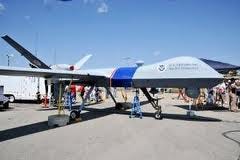DHS is at the forefront of UAV spying

Department of Homeland Security (DHS) says it is the "leading edge" of drone deployment in the United States. Since 2005, DHS has been purchasing Predator drones - officially called unmanned aerial systems (UAS) - to "secure the border," yet these unarmed Predator drones are also steadily creeping into local law enforcement, international drug-interdiction and national security missions - including across the border into the heart of Mexico.
DHS will likely double its drone contingent to two dozen unmanned UAS produced by General Atomics as part of the border security component of any immigration reform. The prominence of border security in immigration reform can't be missed. The leading reform proposal, offered by eight US senators, is the Border Security, Economic Opportunity, and Immigration Modernization Act of 2013 - which proposes to spend $6.5 billion in additional "border security" measures, mostly high-tech surveillance by drones and ground surveillance systems.
Most of the concern about the domestic deployment of drones by DHS has focused on the crossover to law-enforcement missions that threaten privacy and civil rights, and that, without more regulations in place, the program will accelerate the transition to what critics call a "surveillance society." Also alarming is the mission creep of border drones, managed by the DHS' Customs and Border Protection (CPB) agency with increasing interface between border drones, international drug interdiction operations and other military-directed national security missions.
The prevalence of military jargon used by US Customs and Border (CBP) officials - such as "defense in depth" and "situational awareness" - points to at least a rhetorical overlapping of border control and military strategy. Another sign of the increasing coincidence between CBP/Office of Airforce and Marine (OAM) drone program and the military is that the commanders and deputies of OAM are retired military officers. Both Major General Michael Kostelnik and his successor Major General Randolph Alles, retired from US Marines, were highly placed military commanders involved in drone development and procurement.
Increased border security funding and more drones are a core part of all immigration reform proposals being introduced in Congress. However, because of the secrecy and lack of transparency and accountability that is systemic in the DHS border agencies, it is likely neither the Congress nor the US public understands that increasing the number of border security Predators also likely increases the foreign deployment of these drones in nonborder missions over foreign nations and international waters.
Communities, state legislatures and even some congressional members are proceeding to enact legislation and revise ordinances to decriminalize or legalize the consumption of drugs, especially marijuana, targeted by the federal government's drug war of more than four decades. At the same time, DHS has been escalating its contributions to the domestic and international drug war - in the name of both homeland security and national security. Drug seizures on the border and drug interdiction over coastal and neighboring waters are certainly the top operative priorities of OAM. Enlisting its Guardian drones in SOUTHCOM's drug interdiction efforts underscores the increasing emphasis within the entire CBP on counter-narcotic operations.
http://truth-out.org/opinion/item/16422-drones-over-the-homeland-from-border-security-to-national-security
Congress seeks to regulate drone use:
Members of Congress from both parties believe it’s important, perhaps vital, for federal lawmakers to also get ahead of the issue before drones become commonplace in American skies.
“Congress, in the area of drones, needs to set the standards rather than let the courts, down the road, set the standards,” said Rep. Ted Poe, Texas Republican and author of one of several pieces of drone privacy legislation, none of which have been passed. He made the comments at a Friday morning House Judiciary subcommittee crime, terrorism, homeland security investigations hearing on the subject.
Rep. John Conyers, Michigan Democrat, said that drones are such a game-changer on the technological front that the Fourth Amendment — which protects Americans against unreasonable searches and seizures — isn’t enough.
“This is a prime example of technology overtaking established law, and I think we’re going to have to go beyond the Fourth Amendment,” he said. “There are going to have to be a body of statutes that go into some of this in detail.”
Drones are currently used only by the military, a handful of police and sheriff’s departments across the country, by the federal government to monitor its borders and for research and development purposes.
The use of drones, especially by police, will increase dramatically in the coming years as the technology becomes cheaper and easier to use, offering authorities major advantages over airplanes or helicopters.
Privacy experts say that, while laws already exist to prevent spying through bedroom windows or mass, unwarranted, constant surveillance by police, more needs to be done. It’s similar, they say, to how other types of privacy expectations and laws became out of date with the rise of the Internet, email, cell phones and other advances.
“Because of the technology now available, comparing a drone to a traditional aircraft such as a plane or helicopter is like comparing a frisk from a police officer to a modern X-ray machine,” said Tracey Maclin, a professor at Boston University’s School of Law, who testified at Friday’s hearing.
http://www.washingtontimes.com/news/2013/may/17/congress-seeks-regulate-drone-use/


